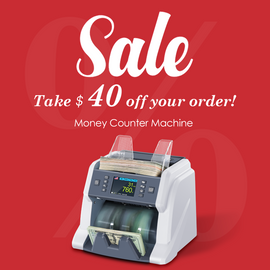In today's world, where counterfeiting techniques are advancing rapidly, the global challenge of ensuring the authenticity of currency and documents has escalated. Understanding the differences between automatic and manual counterfeit detectors is critical for businesses and individuals looking to safeguard their operations. This article provides a comprehensive guide to the nuances of these detectors, helping you make an informed decision.
Overview of Counterfeit Detectors
Counterfeit detection methods are primarily categorized into two types: automatic and manual. Automatic detectors are celebrated for their advanced technology, offering speedy and efficient verification of various security features. Conversely, manual detectors, like UV detectors, excel in versatility, capable of authenticating a wide range of documents, not just currency.
Technology and Functionality
Automatic Detectors
These devices are equipped with sophisticated technology capable of examining multiple security features quickly and with remarkable accuracy. They are especially adept at identifying counterfeit currency, employing techniques such as magnetic, infrared, and watermark detection.
Manual Detectors (UV Detectors)
Manual detectors predominantly use ultraviolet light to ascertain the authenticity of various documents. While they are a staple in currency verification, their utility extends to other significant documents, including passports and checks.
Ease of Use and Training Requirements
Automatic Detectors
These detectors are designed to be user-friendly, necessitating minimal training. Almost anyone can effectively operate them after a brief orientation.
Manual Detectors
In contrast, manual detectors demand a more hands-on approach. Users need to be well-acquainted with the specific security features of different currencies and documents to proficiently identify counterfeits.
Application in Different Business Contexts
The preference between manual and automatic detectors can vary based on a business's unique requirements. Retail settings might favor automatic detectors for their rapidity and simplicity, while the banking sector may lean towards manual detectors for their comprehensive and detailed verification abilities.
Cost Comparison
Automatic detectors usually carry a higher price tag, attributed to their advanced technological features. Manual detectors, offering a broader application scope, present a more budget-friendly option for numerous businesses.
Currency Compatibility
Automatic Detectors
These are often restricted to the number of pre-programmed currencies they can assess, potentially limiting businesses that deal with diverse international currencies.
Manual Detectors
They excel in their capacity to authenticate an extensive range of international currencies, providing superior flexibility.
Portability and Power Requirements
The mobility and power needs of these detectors vary. Automatic detectors are generally less portable and require a constant power source. In contrast, manual detectors boast greater portability and have more versatile power requirements.
Counterfeit Detection Methods
Automatic detectors might employ a blend of magnetic, infrared, and optical sensors. Manual detectors, on the other hand, rely more on visual inspection and UV light verification.
Buying Considerations
When selecting a counterfeit detector, please consider several factors that directly impact its effectiveness and suitability for your business needs:
-
Type of Currency Handled: Different detectors are designed to handle different currencies. It's crucial to select a detector that is compatible with the types of currency your business most frequently encounters.
-
Expertise Level for Counterfeit Identification: Consider the level of expertise your team has in identifying counterfeit currency. While automatic detectors require minimal training, manual detectors demand a deeper understanding of currency features.
-
Validation of Various Documents: If your business also needs to authenticate documents like passports or checks, consider a detector with broader capabilities, such as UV detectors.
-
Volume of Cash Handled: For businesses with high-volume cash transactions, a regular counterfeit detector may not suffice due to the low efficiency and time-consuming nature of handling large amounts of cash. In such scenarios, a money counter machine with integrated counterfeit detection capabilities can be a game-changer. These machines significantly speed up both the counting and authenticity verification processes, saving valuable time and reducing operational costs.
-
Cost and Operational Budget: Weigh the cost of the detector against your operational budget. Automatic detectors typically come with a higher price due to their advanced features, while manual detectors are more budget-friendly but may require more skilled operation.
-
Portability and Power Requirements: Depending on your business's mobility needs, consider the portability and power requirements of the detector. Automatic detectors usually need a constant power source and are less portable, whereas manual detectors offer greater flexibility in these aspects.
By considering these factors, businesses can make a more informed decision, choosing a counterfeit detector that not only meets their immediate needs but also aligns with their long-term operational strategies.
Conclusion
Discerning the key differences between automatic and manual counterfeit detectors is vital for an informed selection. Depending on the specific needs of a business or industry, one type may be more advantageous than the other.







